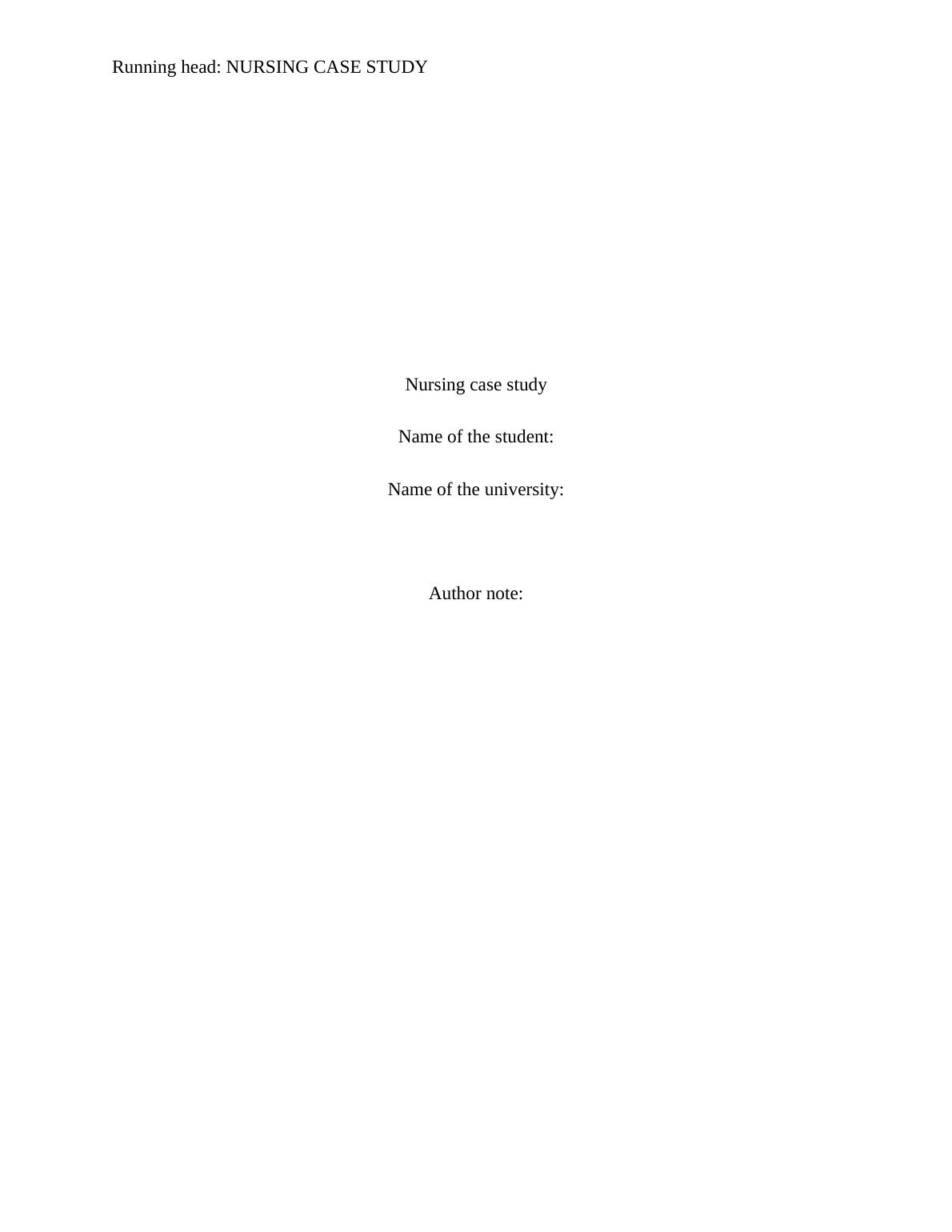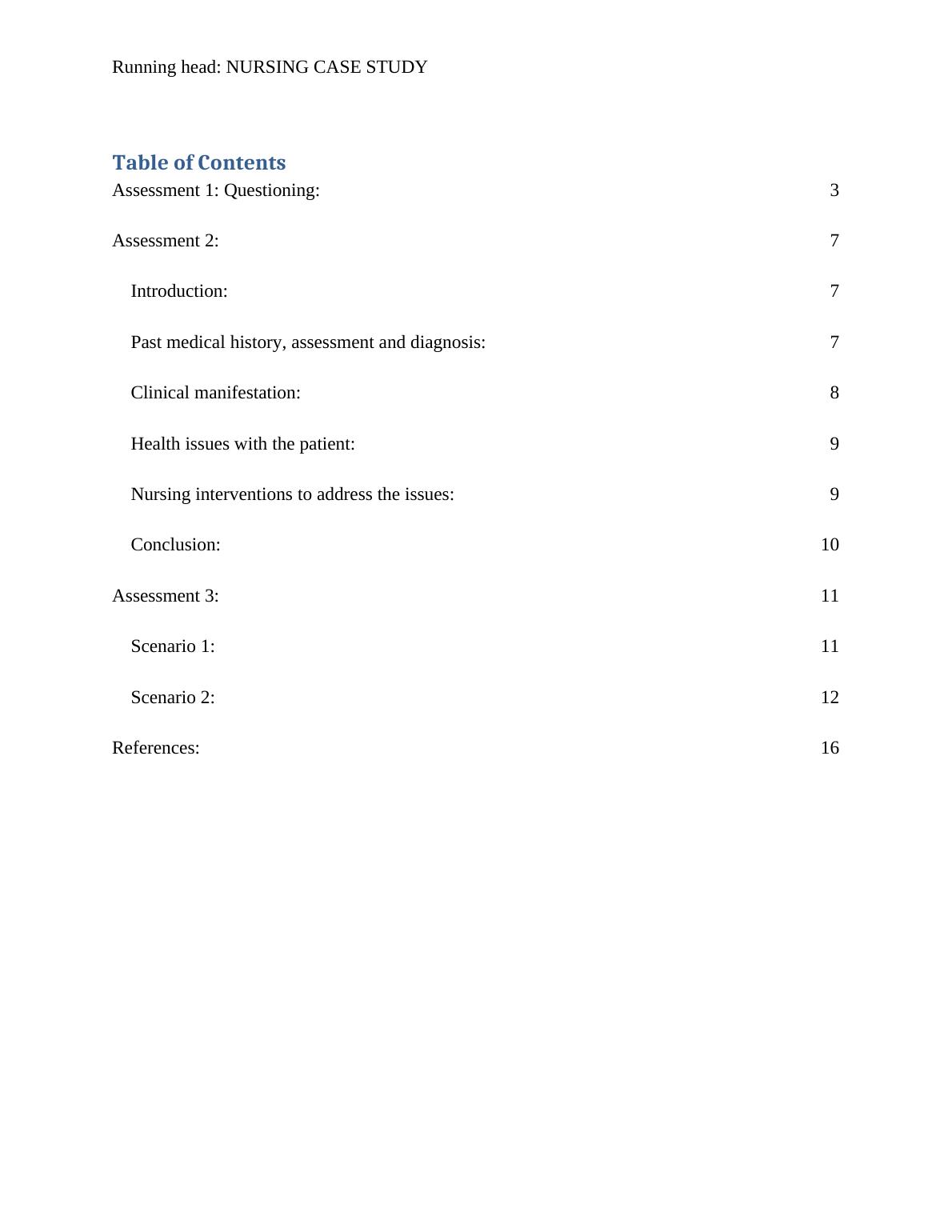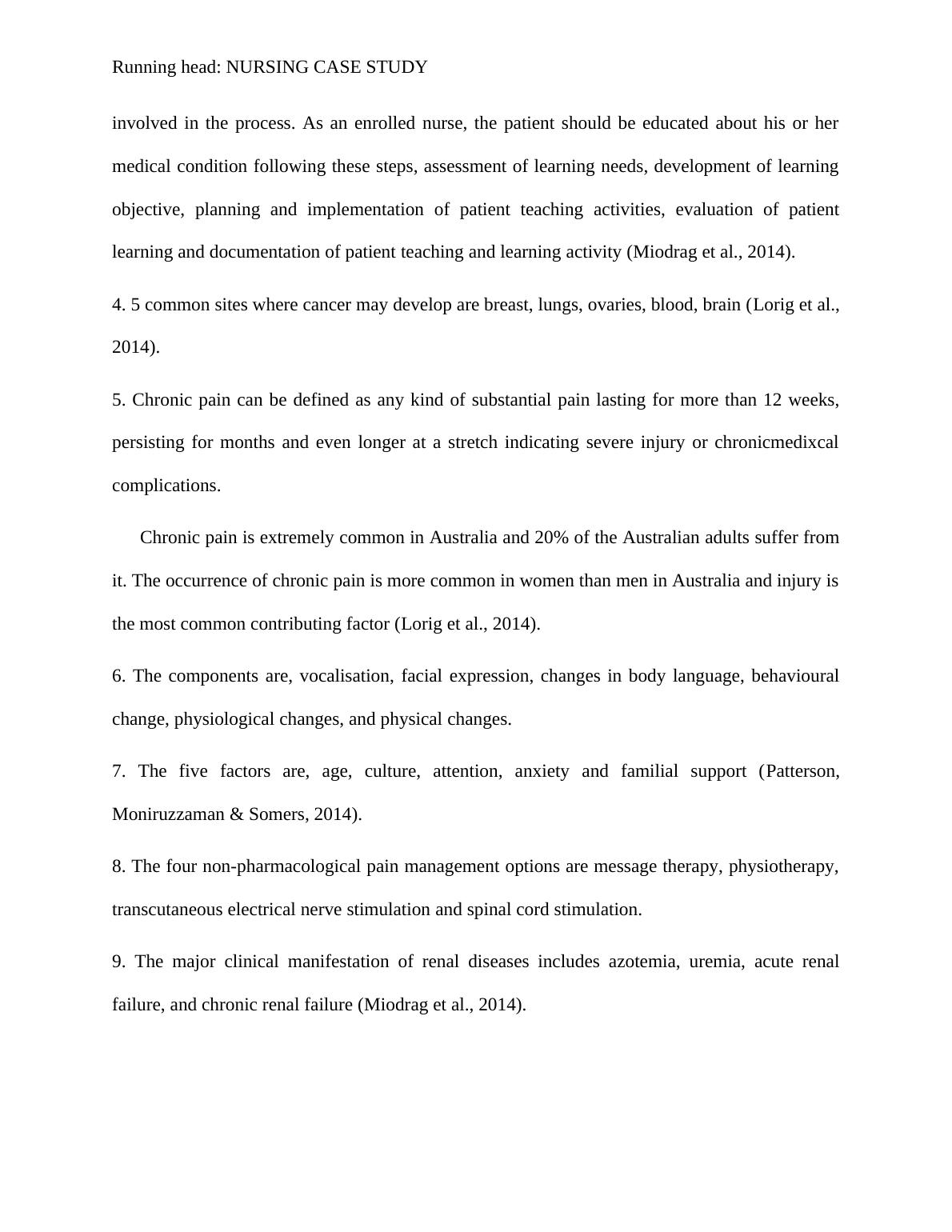Nursing Case Study Chronic Health Diseases
Added on 2020-04-01
23 Pages6453 Words62 Views
Running head: NURSING CASE STUDYNursing case studyName of the student:Name of the university:Author note:

Running head: NURSING CASE STUDYTable of ContentsAssessment 1: Questioning:3Assessment 2:7Introduction:7Past medical history, assessment and diagnosis:7Clinical manifestation:8Health issues with the patient:9Nursing interventions to address the issues:9Conclusion:10Assessment 3:11Scenario 1:11Scenario 2:12References:16

Running head: NURSING CASE STUDYAssessment 1: Questioning:1.5 chronic health conditions: Cancer: It is a chronic health condition characterized by abnormal cell growth andloss of metastasis. Congestive heart failure: It is a fatal health condition occurring when the heart isunable to maintain sufficient blood flowing all throughout the body. Chronic obstructive pulmonary disorder: It is a chronic obstructive progressivelung disorder coupled with symptoms like shortness of breath, coughing and sputumproduction blocking the airways.Asthma: it can be defined as a very common long term chronic inflammatory airwaydisease characterized by recurring symptoms like blocked airways and bronchospasm.Diabetes: It is an extremely common albeit chronic metabolic disorder characterizedby insulin deficiency and prolonged periods of elevated blood sugar levels (Miodrag etal., 2014).2.a. Acute b. chronic c. acute d. chronic e. chronic f. acute 3. Patient education is one of the most important sectors of the health care industry and inorder for the patient to be involved in the entire treatment it is crucial for the patient to be equally

Running head: NURSING CASE STUDYinvolved in the process. As an enrolled nurse, the patient should be educated about his or hermedical condition following these steps, assessment of learning needs, development of learningobjective, planning and implementation of patient teaching activities, evaluation of patientlearning and documentation of patient teaching and learning activity (Miodrag et al., 2014). 4. 5 common sites where cancer may develop are breast, lungs, ovaries, blood, brain (Lorig et al.,2014). 5. Chronic pain can be defined as any kind of substantial pain lasting for more than 12 weeks,persisting for months and even longer at a stretch indicating severe injury or chronicmedixcalcomplications. Chronic pain is extremely common in Australia and 20% of the Australian adults suffer fromit. The occurrence of chronic pain is more common in women than men in Australia and injury isthe most common contributing factor (Lorig et al., 2014). 6. The components are, vocalisation, facial expression, changes in body language, behaviouralchange, physiological changes, and physical changes. 7. The five factors are, age, culture, attention, anxiety and familial support (Patterson,Moniruzzaman & Somers, 2014).8. The four non-pharmacological pain management options are message therapy, physiotherapy,transcutaneous electrical nerve stimulation and spinal cord stimulation. 9. The major clinical manifestation of renal diseases includes azotemia, uremia, acute renalfailure, and chronic renal failure (Miodrag et al., 2014).

Running head: NURSING CASE STUDY10. Asthma is one of the most common chronic respiratory disorders and clinical signs andsymptoms of it include: severe wheezing, recurrent coughing, shortness of breath, chest pain andswollen chest and neck muscles or retractions (Patterson, Moniruzzaman & Somers, 2014). 11. Asthma is a respiratory disorder that is triggered very easily, three significant causes ofasthma include: airborne substance allergy for instance with pollens, fungal spores, dust mites,danders, etc. Another significant cause to asthma can be different respiratory infections, and thethird most common cause to asthma is air pollutants, irritants or extremely cold air(Moniruzzaman & Somers, 2014). 12. Ventollin is a highly critical drug used for bronchospasm and the oral inhalation of thismedication is carried out by the aid of spacers and inhalers. Although these drugs can be selfadministered but the nursing professionals must ensure educating the patient properly about theusage of spacer and inhalers and the correct dosage. In case of ventollin 180 mcg is needed incase of adult patients, and the spacers inside the inhaler device stores the medication and ensurea regulated dosage being administered to the patient easing the procedure of self administration(Miodrag et al., 2014). 13. Four common symptoms of COPD or chronic obstructive pulmonary disorder include:shortness of breath during strenuous activities, excessive wheezing, a chronic cough withexcessive sputum production, ad tightness in the chest muscles (Fisher & Dickinson, 2014). 14. COPD is a common respiratory disorder and there are a number of different risk factors thatcontribute to it. Six risk factors of common causes to is are excessive smoking, excessivesensitivity to air pollutants, long term exposure to industrial dust and chemical, geneticpredisposition or inclination, age more than 40 and past medical susceptibility to chronicrespiratory infections (Fisher & Dickinson, 2014).

Running head: NURSING CASE STUDY15. Cardiac dysfunction is one of the most common age related medical complication which isseen very frequently in middle aged men and women. The common diagnostic tests that areperformed while assessing a cardiac dysfunction include: physical examination is the first stepwhere the patient will be checked thoroughly for signs of any physical manifestation of clinicalcomplications. The second set of tests is blood tests followed by regular chest Xrays. The fourthtest performed on a cardiac patient is electrocardiogram or ECG, which is theb most commontest for cardiac disorders, which shoes the ventricles in detail or any abnormality. The fifth testpreformed are echocardiography which provides more details on the interior of heart ventriclesand muscles, and the sixth is the magnetic resonance imaging or MRI which shows the internalstructures of the heart in acute details (Henry & Schor, 2015). 16. 4 risk factors for stroke are smoking, high blood pressure, diabetes, and aging (Chiauzzi,Rodarte & DasMahapatra, 2015).17. Rheumatoid arthritis: It is an autoimmune disease causing chronic inflammation of the jointsand extreme pain and other discomfort.Ankylosing spondylitis: it is a type of the arthritis of the spine causing extreme pain andstiffness along the spine. Gout: Gout is a type of arthritis caused by the accumulation of uric acid crystals in the joints(Lorig et al., 2014).

End of preview
Want to access all the pages? Upload your documents or become a member.
Related Documents
Relevant Pathophysiology of Acute Exacerbation of Asthmalg...
|9
|2337
|280
A Case Study of the Management of Asthmatic Patient at a Community Cliniclg...
|19
|5555
|464
Clinical Decision Task 2022lg...
|10
|3621
|21
Nurses Care Practice Case Study 2022lg...
|7
|1986
|20
Case Study on Acute Asthma Attack Patientlg...
|13
|3533
|60
Management 0f Acute Condition Question Answer 2022lg...
|36
|7892
|33